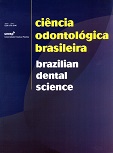Reação tecidual e perfil de fosfatases após o implante de matriz óssea desmineralizada xenogênica em músculo de ratos
DOI:
https://doi.org/10.14295/bds.2005.v8i2.393Abstract
Neste estudo correlacionou-se o perfil da atividade das fosfatases ácidas com os aspectos histológicos do tecido reacional em resposta à implantação subcutânea de biomaterial de enxerto preparado com matriz óssea desmineralizada bovina. Cinqüenta ratos Wistar machos foram submetidos a implantação do enxerto e sacrificados após 7, 14, 21, 30 e 67 dias. As biópsias obtidas foram fixadas em formalina 10% em tampão fosfato e cortes histológicos de 6 μm de espessura foram corados com hematoxilina e eosina. As atividades enzimáticas específicas (AE) das fosfatases ácidas foram determinadas utilizando-se o p-nitrofenilfosfato (pNFF) como substrato em tampão acetato, pH 5,0, e inibidores específicos. Para a fosfatase alcalina (FALc) foi utilizado o pNFF em tampão glicina, pH 9,2, contendo CaCl2. A análise histológica mostrou infiltrado inflamatório crônico com predomínio de macrófagos e linfócitos e presença de células gigantes multinucleadas, reabsorção do enxerto ao longo do tempo, estando ausente aos 67 dias; não pode ser observada formação óssea heterotópica. A atividade da fosfatase ácida total foi elevada e constante entre 7 e 30 dias, cerca de 30,0 nmol min-1mg-1, decaindo, em seguida, para 6,9 nmol min-1mg-1, enquanto a atividade da fosfatase alcalina foi baixa, com valor máximo de 6,0 nmol min-1mg-1 aos 30 dias. As atividades PTP, FAL e TRAP corresponderam, respectivamente, a cerca de 70, 25 e 10% da FAT. Concluímos que o enxerto de matriz óssea bovina desmineralizada não induziu a osteogênese heterotópica e que as fosfatases ácida e alcalina participaram da resposta tecidual, sendo moduladas em função do tempo.Downloads
Downloads
Published
How to Cite
Issue
Section
License
Brazilian Dental Science uses the Creative Commons (CC-BY 4.0) license, thus preserving the integrity of articles in an open access environment. The journal allows the author to retain publishing rights without restrictions.
=================




























